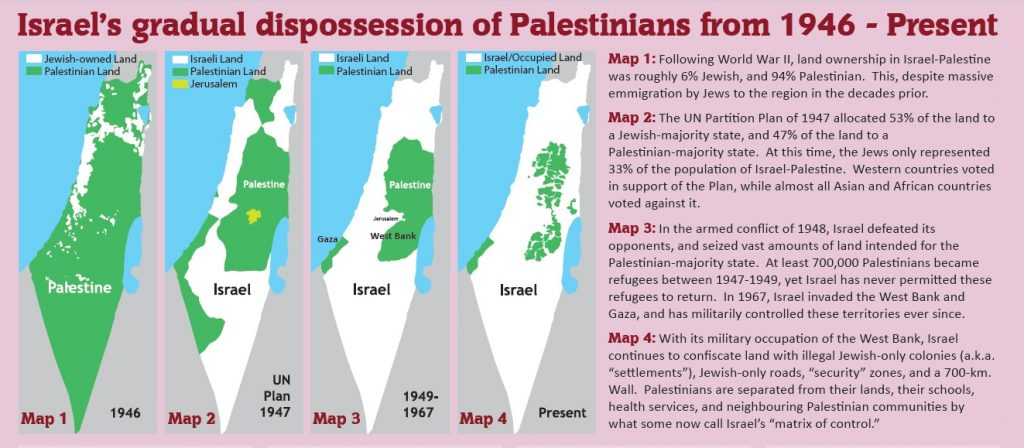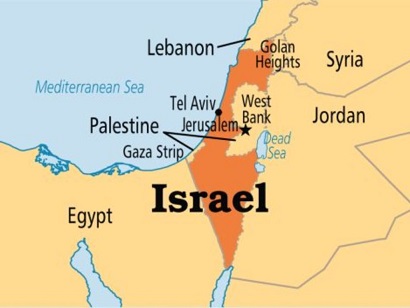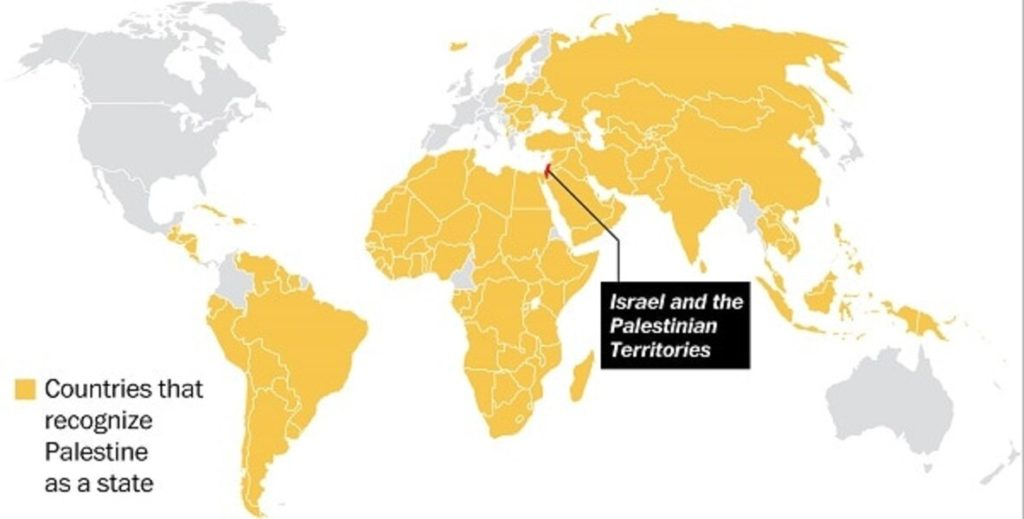Contents
- Why has the Israel-UAE pact unsettled Palestine and Iran?
- What has made the Naga peace process wobble?
- Freedom and identity, the right to be
- Govt’s move to Increase bioethanol in petrol
- What ails with the Agriculture Infrastructure Fund?
WHY HAS THE ISRAEL-UAE PACT UNSETTLED PALESTINE AND IRAN?
Focus: GS-II International Relations
Introduction
- U.S. President Donald Trump announced that Israel and the United Arab Emirates (UAE) had reached a peace agreement.
- Many countries, including the European powers and India, have welcomed it, while the Palestinian leadership as well as Turkey and Iran have lashed out at the UAE.
About the deal and its significance
- According to the joint statement, the UAE and Israel would establish formal diplomatic relations and in exchange, Israel would suspend its plans to annex parts of the occupied West Bank.
- It’s a landmark agreement given that the UAE is only the third Arab country and the first in the Gulf region to establish diplomatic relations with Israel.
- If more countries in the Gulf follow the UAE’s lead, it would open a new chapter in Arab-Israel ties.
A bit of history
- Arab-Israeli ties have historically been conflict-ridden – Arab countries, including Egypt, Transjordan, Syria and Iraq, fought their first war with Israel in 1948 after the formation of the state of Israel was announced.
- The war ended with Israel capturing more territories, including West Jerusalem, than what the UN Partition Plan originally proposed for a Jewish state.
- After that, Israel and Arab states fought three more major wars — the 1956 Suez conflict, the 1967 Six-Day War and the 1973 Yom Kippur War.
- After the 1967 war in which Israel captured the Sinai Peninsula and Gaza Strip from Egypt, East Jerusalem and the West Bank from Jordan and the Golan Heights from Syria, Arab countries convened in Khartoum and declared their famous three “‘Nos’ — no peace with Israel, no talks with Israel and no recognition of Israel”, which did not last long.
Path to peace
- Egypt became the first country to conclude a peace treaty with Israel, as part of which Israel withdrew from Sinai in return for Egyptian recognition.
- Following the Oslo Accords, under which the Palestine Liberation Organization (PLO) recognised Israel and was allowed to form the Palestinian Authority in the West Bank and Gaza, time was ripe for an Israel-Jordan deal. The enmity between the two countries came to an end in July 1994 with the Washington Declaration.
Why did the UAE sign the agreement?
- The old enmity between Arab countries and Israel has dissipated.
- The Sunni Arab kingdoms in the Gulf region such as Saudi Arabia and the UAE had developed backroom contacts with Israel over the past several years.
- One of the major factors that brought them closer has been their shared antipathy towards Iran.
- In 2019, the U.S. brokered a security conference in Warsaw to build a global strategy against Iran. The meeting brought leaders from Israel, Saudi Arabia, the UAE and several other countries closer.
Sweet-spot
Arab countries have signalled that they are ready to live with Israel’s occupation of Palestine. What they do not want is a major change in the status quo which would put them under political and diplomatic pressure.
Where does it leave the Palestinians?
- The UAE-Israel deal, Israel has not made any actual concession to the Palestinians, as the annexation plan on Palestine by Israel was a threat. The withdrawal of the threat was packaged as a concession, which the Emiratis accepted.
- Hence, the Palestinians are upset with the deal.
What are the geopolitical implications of the deal?
- The agreement could fast-track the changes that are already under way in the region.
- The Saudi bloc, consisting of Egypt, the UAE, Bahrain and others, see their interests being aligned with that of the U.S. and Israel and their support for Palestine, which Arab powers had historically upheld, is dwindling, while Turkey and Iran emerge as the strongest supporters of the Palestinians in the Muslim world, and this tripolar contest is already at work in West Asia. The UAE-Israel thaw could sharpen it further.
Israel – Palestine Conflict
- The Israeli–Palestinian conflict is the ongoing struggle between Israelis and Palestinians that began in the mid-20th century.
- The origins to the conflict can be traced back to Jewish immigration and sectarian conflict in Mandatory Palestine between Jews and Arabs.
- Despite a long-term peace process and the general reconciliation of Israel with Egypt and Jordan, Israelis and Palestinians have failed to reach a final peace agreement.
- The key issues are mutual recognition and security, borders, water rights, control of Jerusalem, Israeli settlements, Palestinian freedom of movement, and Palestinian right of return.


What is the Two-state Solution?
- The two-state solution to the Israeli–Palestinian conflict envisages an independent State of Palestine alongside the State of Israel, west of the Jordan River.
- The boundary between the two states is still subject to dispute and negotiation, with Palestinian and Arab leadership insisting on the “1967 borders”, which is not accepted by Israel.
- Many attempts have been made to broker a two-state solution, involving the creation of an independent Palestinian state alongside the State of Israel (after Israel’s establishment in 1948).
- In 2007, the majority of both Israelis and Palestinians, according to a number of polls, preferred the two-state solution over any other solution as a means of resolving the conflict.
India’s stand in the Israel – Palestine conflict:
Historically
- In the early 1920s and amidst the Khilafat struggle, Indian nationalists made common cause with the Arabs of Palestine and adopted a position that was unsympathetic to the Jewish aspirations for a national home in Palestine.
- Mahatma Gandhi’s 1938 statement said “Palestine belongs to the Arabs in the same sense that England belongs to the English and France to the French”.
- Prime Minister Narasimha Rao hosted Arafat in 1992 for the first time and signalled India’s intention of abandoning its four decades old policy of non-relations with Israel.

India has consistently voted in favour of those resolutions that promote the two-state solution with a Palestinian claim to East Jerusalem.
Peace based on two-state solution is much needed in the face of international proposals that are in breach of these principles, and cannot be forged between Israel and a third country [U.S.], but can only come from Israel-Palestine talks, which India also supports.
-Source: The Hindu
WHAT HAS MADE THE NAGA PEACE PROCESS WOBBLE?
Focus: GS-I Indian Society, History, GS-II Governance
Introduction
After a framework agreement was signed in 2015 between the Centre and the Isak-Muivah faction of the National Socialist Council of Nagalim, or the NSCN (I-M), the largest of the extremist groups in the peace process since 1997, there have been more than 100 rounds of talks and several twists and turns.
What has made the peace process wobble?
- As the Centre’s interlocutor, Mr. Ravi had signed the framework agreement, hence his appointment was seen as a message from New Delhi that the solution would be found soon. But, he issued a statement blaming the “procrastinating attitude” of the NSCN (I-M) for the delay in a mutually-agreed draft comprehensive settlement.
- His letter referring to ‘them’ as “armed gangs” running parallel governments led to the NSCN (I-M) demanding Mr. Ravi’s removal from the peace process but the Naga National Political Groups (NNPGs).
What is the ‘framework agreement’?
- On August 3, 2015, the Centre signed a framework agreement with the NSCN (I-M) to resolve the Naga issue, but both the sides maintained secrecy about its contents.
- The optimism among some Naga groups eroded a bit when the NNPGs were brought on board the peace process on 2017.
- This agreement ostensibly made the peace process inclusive but it created suspicion about Delhi exploiting divisions within the Nagas on tribal and geopolitical lines.
Why is the ‘agreement’ in the news?
- The NSCN (I-M) recently released the contents of the framework agreement.
- The NSCN (I-M) claimed that the word “new” in the original agreement was a politically sensitive word that defined the meaning of peaceful co-existence of the two entities (sovereign powers) and strongly indicated a settlement outside the purview of the Constitution of India.
What are the other hurdles?
- In his ‘Naga Independence Day’ speech on August 14, NSCN (I-M) general secretary insisted the Nagas “will never merge with India”.
- But States adjoining Nagaland, where the peace headquarters of NSCN (I-M) is located, are apprehensive of the sovereignty issue.
- This is because of the NSCN (I-M)’s idea of Greater Nagalim — a homeland encompassing all Naga-inhabited areas in Nagaland and beyond.
- Apart from Myanmar, where many of more than 50 Naga tribes live, the Greater Nagalim map includes large swathes of Arunachal Pradesh, Assam and Manipur.
Stance of States regarding the NSCN (I-M)’s position
- The Assam government has vowed not to part with “even an inch of land”.
- The All Arunachal Pradesh Students’ Union warned against any “territorial changes” while finding a solution.
- Manipur Chief Minister said he has received the Centre’s assurance that the peace deal with the NSCN (I-M) will not affect the territorial integrity of Manipur.
Click Here to read more about the Naga peace accord and the Greater Nagalim demand
-Source: The Hindu
FREEDOM AND IDENTITY, THE RIGHT TO BE
Focus: GS-II Governance
Introduction
- Tulsidas, who wrote one of the several influential versions of the Ramayana, described Ram Rajya as a place where everyone felt free to do what they were supposed to do and where there was no fear, sorrow or disease.
- Mahatma Gandhi recognised the values of Ram Rajya as a shared universal consciousness.
- Underlying the articulation of both these exponents of Ram Rajya was the conception of a citizen as a free being.
Adhyātma
- Life as we know it is not free entirely, because we are bound by one law or the other.
- So, what is required to find freedom is just this knowledge, this awareness, that if you look beyond your physical form to your original state, which is formless and free, you indeed become free.
- Classical Indian wisdom calls this state adhyātma. The compound word adhyātma is a combination of two words, adhi+atma which means awareness of self.
- Living in the light of atma or self is the true meaning of Swarajya. Etymologically, Swarajya means, swena rajate or self-luminous existence.
Making the connection
- The Preamble of the Indian Constitution promises the delivery of aspirational values of justice, liberty, equality and fraternity for its citizens.
- They make sense only when the average Indian realises the freedom to be and not be co-opted by the politics of identity, machinations of the market or the dictatorship of the digital world.
- Swarajya in thought and education that liberates the free being, sa vidya ya vimuktaye, can only rescue India from a myopia of the post-colonial leadership.
-Source: The Hindu
GOVT’S MOVE TO INCREASE BIOETHANOL IN PETROL
Focus: GS-III Environment and Ecology
Introduction
- The government has set targets of 10 per cent bioethanol blending of petrol by 2022 and to raise it to 20 per cent by 2030 under the ethanol blending programme to curb carbon emissions and reduce India’s dependence on imported crude oil.
- 1G and 2G bioethanol plants are set to play a key role in making bio-ethanol available for blending but face challenges in attracting investments from the private sector.
What are 1G and 2G biofuel plants?
- 1G bioethanol plants utilise sugarcane juice and molasses, byproducts in the production of sugar, as raw material, while 2G plants utilise surplus biomass and agricultural waste to produce bio-ethanol.
- Currently, domestic production of bioethanol is not sufficient to meet the demand for bio-ethanol for blending with petrol at Indian Oil Marketing Companies (OMCs).
Why are Indian plants not able to meet the demand for bio-ethanol?
- Experts point out that many sugar mills which are best placed to produce bioethanol do not have the financial stability to invest in biofuel plants and there and there are also concerns among investors on the uncertainty o the price of bio-ethanol in the future.
- The prices of both sugarcane and bio-ethanol are set by the central government.
- The price of obtaining agricultural waste required for the production of bio-ethanol at 2G plants was currently too high for it to be viable for private investors in the country.
What can be done to boost investment in bioethanol production?
- State governments may set up depots where farmers could drop their agricultural waste and that the central government can fix a price for agricultural waste to make investments in 2G bioethanol production an attractive proposition.
- The government could provide greater visibility on the price of bioethanol that sugar mills can expect by announcing a mechanism by which the price of bio-ethanol would be decided.
Click Here to read more about National Policy on Biofuels
-Source: Indian Express
WHAT AILS WITH THE AGRICULTURE INFRASTRUCTURE FUND?
Focus: GS-III Agriculture
Introduction
- The Prime minister launched the Rs 1 lakh crore Agriculture Infrastructure Fund (AIF) to be used over the next four years to build post-harvest storage and processing facilities.
- The fund will also be used to provide loans, at concessional rates, to FPOs and other entrepreneurs through primary agriculture credit societies (PACs).
- NABARD will steer this initiative in association with the Ministry of Agriculture and Farmers Welfare.
Concerns
- Unless NABARD ensures that FPOs get their working capital at interest rates of 4 to 7 per cent — like farmers get for crop loans — the mere creation of storage facilities will not be enough to benefit farmers.
- The future of the agri-futures markets is missing. A vibrant futures market is a standard way of hedging risks in a market economy. Several countries — be it China or the US — have agri-futures markets that are multiple times the size of those in India.
How do we fix this?
- As NABARD forms FPOs and creates basic storage facilities through the AIF, it should devise a compulsory module that trains FPOs to use the negotiable warehouse receipt system and navigate the realm of agri-futures to hedge their market risks
- Government agencies dabbling in commodity markets should increase their participation in agri-futures.
- The banks that give loans to FPOs and traders should also participate in commodity futures as “re-insurers” of sorts for the healthy growth of agri-markets.
- Government policy has to be more stable and market-friendly.
Click Here to read more about the Agricultural Infrastructure Fund
-Source: Indian Express





